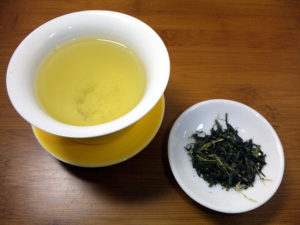
Did you know that there are more than 600 volatile compounds in tea?
They are responsible for aroma as well as flavor.
It’s not entirely clear how each compound contributes to the general aroma profile for a given tea.
This isn’t just a matter of adding each aroma and calculating the total.
At different concentrations, the aroma of each compound can change. Plus, it can interact with other aromas, which further complicates things.
For example, Indole has a floral aroma at low concentrations but at higher concentrations it feels like a fecal smell.
Linalool and geraniol have a floral aroma. They are more prevalent in Chinese green teas than in Japanese teas.
Leaf alcohol (cis-3-Hexen-1-ol) is responsible for the fresh aroma of Japanese green teas, especially those from earlier harvests.
Dimethyl sulphide imparts the seaweed aroma to Japanese green tea, and it is found in higher quantities when there is a shading process. A good example is gyokuro.
Pyrazines give houjicha its roasted aroma.
Below is a list of some of the aroma compounds in green tea according to Tei Yamanishi of Ochanomizu University:
Hydrocarbons
Toluene, C7H8 ; Limonene, C10H16 ; ⍺-Cubebene, C15H24 ; ⍺-Copaene, C15H24 ; Caryophyllene, C15H24 ; γ-Muurolene, C15H24 ; ⍺-Muurolene, C15H24 ; δ-Cadinene, C15H24 ; Calamenene, C15H24 ; ⍺-Humulene, C15H24 ; β-Sesquiphellandrene, C15H24
Alcohols
2-Methylpropanol, C4H10O ; Butanol, C4H10O ; Furfurylalcohol, C5H6O2 ; 1-Penten-3-ol, C5H10O ; cis-2-Penten-1-ol, C5H10O ; 3-Methylbutanol, C5H12O ; Pentanol, C5H12O ; cis-3-Hexen-1-ol, C6H12O ; trans-2-Hexen-1-ol, C6H12O ; Hexanol, C6H14O ; Benzyl alcohol, C7H8O ; Heptanol, C7H16O ; 2-Phenylethanol, C8H10O ; 1-Phenylethanol, C8H10O ; Octanol, C8H18O ; Nonanol, C9H20O ; 3s-( + )-3,7-Dimethyl-1,5,7-octatrien-3-ol, C10H16O ; Linalool, C10H18O ; Nerol, C10H18O ; Geraniol, C10H18O ; ⍺-Terpineol, C10H18O ; Linalool oxide I (cis, furanoid), C10H18O2 ; Linalool oxide II (trans, furanoid), C10H18O2 ; Linalool oxide III (liquid, pyranoid), C10H18O2 ; Linalool oxide IV (solid, pyranoid), C10H18O2 ; Nerolidol, C15H26O ; ⍺-Cadinol, C15H26O ; Cubenol, C15H26O ; epi-Cubenol, C15H26O
Aldehydes
trans-2-Hexenal, C6H10O ; 5-Methylfurfural, C6H6O2 ; Benzaldehyde, C7H6O ; Heptanal, C7H14O ; Nonanal, C9H18O
Ketones
Acetophenone, C8H8O ; trans-3,trans-5-Octadien-2-one, C8H12O ; 6-Methyl-trans,trans-3,5-heptadien-2-one, C8H12O ; trans-3-Octen-2-one, C8H14O ; cis-Jasmone, C11H16O ; ⍺-Ionone, C13H20O ; β-Ionone, C13H20O ; Genarylacetone, C13H22O ; 3,4-Dihydro ⍺-ionone, C13H22O ; Theaspirone, C13H20O2 ; 6,10,14-Trimethylpentadecan-2-one, C18H36O2
Esters
cis-3-Hexenyl butyrate, C10H18O2 ; cis-3-Hexenyl trans-2-hexenoate, C12H20O2 ; Neryl acetate, C12H20O2 ; ⍺-Terpinyl acetate, C12H20O2 ; cis-3-Hexenyl hexanoate, C12H22O2 ; cis-3-Hexenyl benzoate, C13H16O2 ; Methyl jasmonate, C13H20O3
Lactones
Coumarin, C9H6O2 ; Jasmine lactone, C10H16O2 ; Dihydroactinidiolide, C11H16O2
Acids
Butyric, C4H6O2 ; Pentanoic, C5H10O2 ; cis-3-Hexenoic, C6H10O2 ; trans-2-Hexenoic, C6H10O2 ; Hexanoic, C6H12O2 ; Benzoic C7H6O2 ; trans-Geranic, C10H16O2 ; Decanoic, C10H20O2
Phenols
Phenol, C6H6O ; o-Cresol, C7H8O ; m-,p-Cresol, C7H8O ; Salicylic acid, C7H6O3 ; Methylsalicylate, C8H8O3 ; 4-Vinylphenol, C9H10O2 ; 4-Ethylguaiacol, C9H12O2 ; Isoeugenol, C10H12O2 ; Vanillin, C8H8O3
Miscellaneous oxygenated compounds
1,4-Dimethoxybenzene, C8H10O2 ; Anethol, C10H12O
Sulfur compounds
Hydrogen sulfide, H2S ; Dimethylsulfide, C2H6S
Nitrogenous compounds
2-Acetylpyrrole, C6H7ON ; 1-Ethyl-2-formylpyrrole, C7H9ON ; Indole, C8H7N ; Benzylcyanide, C8H7N ; 1-Ethyl-2-acetylpyrrole, C8H11ON ; Diphenylamine, C12H11N
Pyrazines
Methylpyrazine, C5H6N2 ; 2,3-Dimethylpyrazine, C6H8N2 ; 2,5-Dimethylpyrazine, C6H8N2 ; 2,6-Dimethylpyrazine, C6H8N2 ; Ethylpyrazine, C6H8N2 ; 2-Ethyl-3-methylpyrazine, C7H10N2 ; 2-Ethyl-5-methylpyrazine, C7H10N2 ; 2-Ethyl-6-methylpyrazine, C7H10N2 ; Trimethylpyrazine, C7H10N2 ; 2,5-Diethylpyrazine, C8H12N2 ; 2,6-Diethylpyrazine, C8H12N2 ; 3-Ethyl-2,5-dimethylpyrazine, C8H12N2 ; Tetramethylpyrazine, C8H12N2 ; 2,5-Diethyl-3-methylpyrazine, C9H14N2 ; 2,6-Diethyl-3-methylpyrazine, C9H14N2 ; 6,7-Dihydro-5H-cyclo-pentapyrazine, C7H8N2 ; 2-Methyl-6,7-dihydro-5H-cyclo-pentapyrazine, C8H10N2 ; 5-Methyl-6,7-dihydro-5H-cyclo-pentapyrazine, C8H10N2 ; 2-(2′-Furyl)-pyrazine, C8H6ON2 ; 2-(2′-Furyl)-5(or 6)-methylpyrazine, C9H8ON2
Sources:
A Comparison of the Volatile Compounds in Several Green Teas

September 8, 2020
Wow, thanks for taking the time to type all of those formulas!
September 8, 2020
Hi David, thanks for reading.